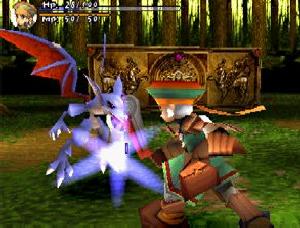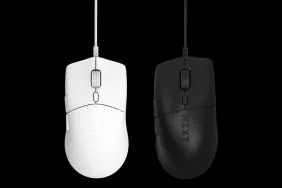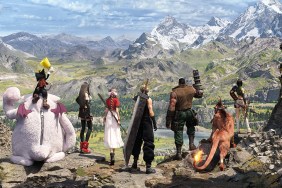Fated to be a classic? Probably not.
RPGs often suffer from LOOPS – Lack Of Original Plot Syndrome. With the hundreds
of RPGs that have been released over the years, designers have still managed to
only come up with 4 plot lines: save the world, save the girl, get revenge, and
find the treasure. With an auspicious name like Threads of Fate, I was
hoping for the complex stories of two youths entwined in the events of a changing
world. Instead, I was handed a lukewarm bedtime story about 2 shallow kids both
seeking the legendary “Relic.”
The legendary “Relic” is just that, a legend. Like all good mythical items,
the “Relic” was created in a lost age by a lost race, and it was the last and
greatest achievement of a powerful sorcerer (and you know it’s important because
it always appears in little quotation marks). No one really knows what the “Relic”
does, but both characters in Threads of Fate are willing to risk their
lives to get it because they believe it has the power to grant them their greatest
desire.
In order to quest for the “Relic” you must assume the role one of two characters – Rue or Mint. Rue, the male character, wants the “Relic” so that he can bring back his lover who was killed 3 years ago, while Mint, the female character, wants the “Relic” so that she can prove she’s worthy to inherit her father’s kingdom and take over the world. No matter which character you choose, you will periodically encounter the other during the game as you compete to get the “Relic.”
Each character has special talents. Rue is a strong fighter with the ability to morph into any monster he has recently dispatched and Mint is a little more agile with some very powerful magic spells. The characters are well balanced against each other and the game design is a little different depending on which character you choose (there is also one level specifically for each character).
The controls in ToF are fairly simplistic. There’s a basic attack/action
button, a strong attack button (or a magic button if you play as Mint), a jump
button and a change magic/monster button. Missing from ToF are the rotate
camera buttons that are often found in similar games. Technically these buttons
do exist, but they’re about as useful as a bag of lint. The reason for this
is the fact that in 95% of the game, the camera is fixed (meaning that there
won’t be any hidden passageways revealed by turning the camera) and the only
time you can rotate the camera around is in certain buildings in town. Unless
you really want to see the back of the bartender’s head, you probably won’t
use the camera controls.
Paralleling the limited camera movement is the overall lack of interactivity
in the game. There is only one town, and aside from the various store owners
there are a total of about 5 people who you can talk to and they have nothing
much to say.
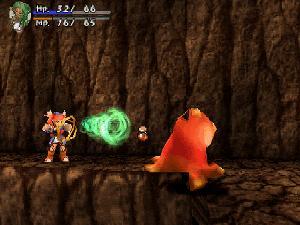 Those
Those
five include a guy named Rod, who you can fight to build up your character,
an archeologist, who will help you study the clues you find in the dungeons,
a girl names Elena, who is annoying at best, and a couple other people who have
no purpose other than to walk around and provide the inane “town chatter” found
in all RPGs.
One would hope that with only a boring little town to explore, the surrounding
world would be pretty cool…nope. When you leave the town there is no “world”
at all, just a series of areas with enemies. To get to these areas you must
go to the town gate and then choose a destination and voila, you’re magically
zipped there. This is one of the most disappointing aspects of the game.
Similar games like Brave Fencer Musashi supplemented
a basic plotline and singular town with an environment that held lots of secrets,
which could often only be discovered through special abilities gained throughout
the game. However, in ToF the only reason to re-visit a level is to get
money and experience. In fact, all too often I felt like the only purpose of
the game was character building and, unless you have an unhealthy god complex,
character building can get pretty dull.
The game control itself is decent if unforgiving. There are a few too many
precision-based jumps. Unfortunately, the jump button tends to fail at the worst
times. I can’t tell you how irritating it gets to lose a battle because I missed
a jump over and over again, causing me to lose precious hit-points.
Aside from technical maneuvers, there are some other parts of ToF that
are just plain irritating. Sometimes the game uses a “dynamic” camera angle
to increase the cinematic feel, but instead only makes the game unnecessarily
difficult (when you get to the rolling boulder scene you’ll know what I mean).
Jumps become harder to judge, enemies harder to hit, and obstacles remain out
of sight until it’s too late.
In the end, the combination of these elements turns ToF from an average
action/RPG suitable for the masses into a game that will probably only be appreciated
by die-hard fans of the genre. If you happen to be a serious RPG enthusiast
then you might want to give it a shot, but if you’ve never been too impressed
with this type of game, Threads of Fate won’t be the one to change your
mind.
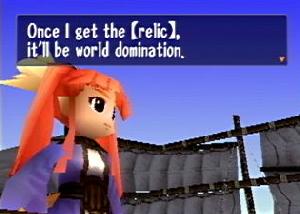
-
Two story lines
-
Cool special abilities
-
Tedious gameplay
-
Very few secrets
-
As many plot twists as you can count on 1 finger
